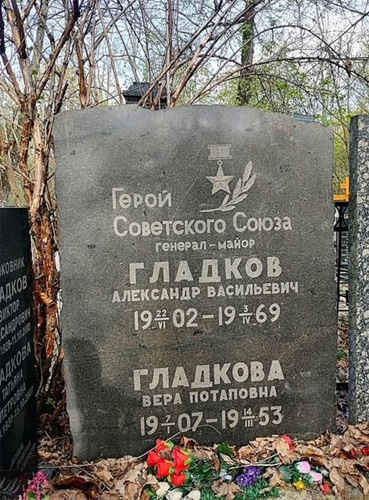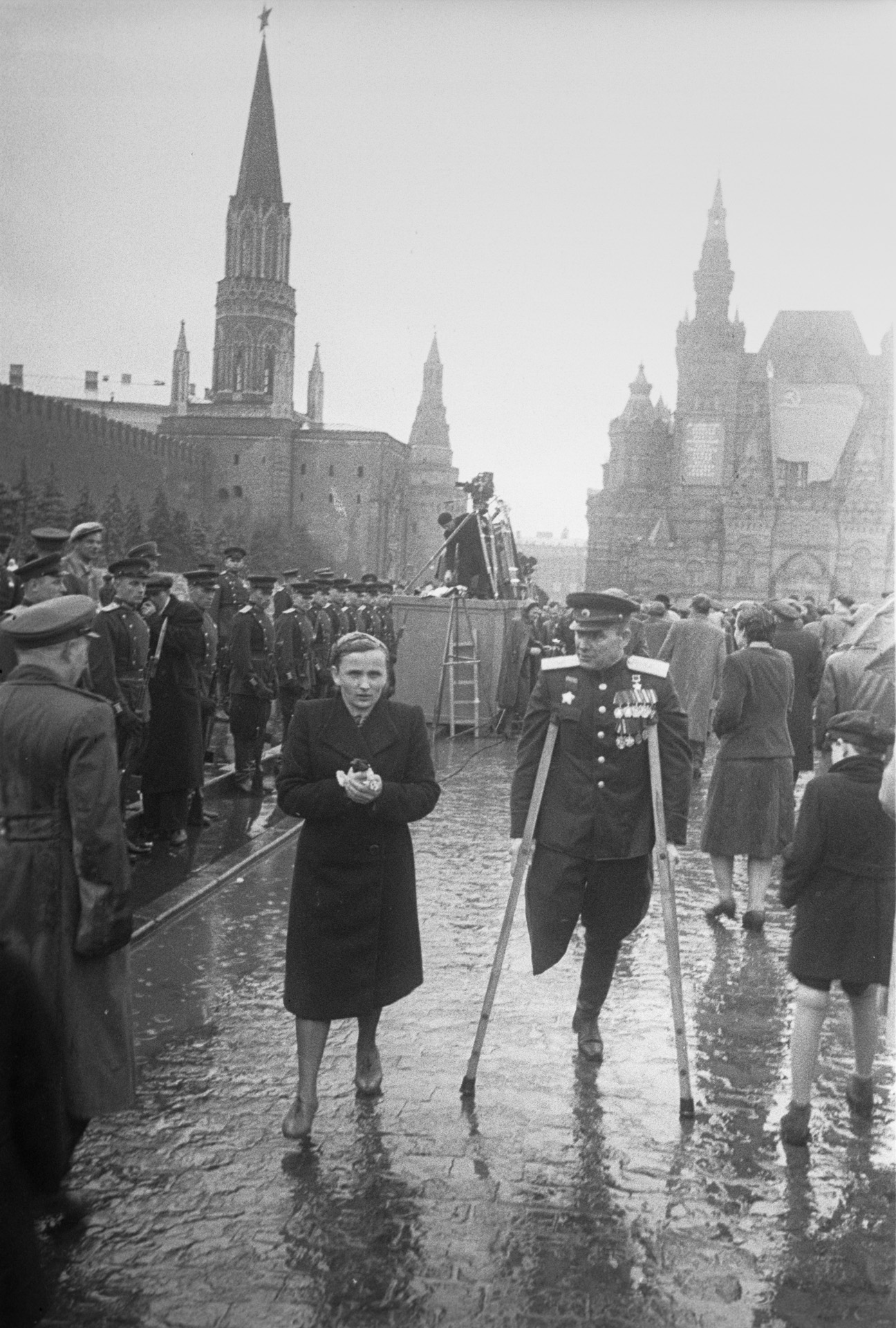«The Joy and Pain of Victory»
1945
This photograph was taken by the renowned photographer Yevgeny Khaldei shortly after the Victory Parade in Moscow on 24th June, 1945. The weather that day was overcast and rainy, yet people were jubilant – it was the Victory Parade after all! Despite the overwhelming joy of the triumph over a strong and ruthless enemy, the elation was accompanied by sorrow and pain from the losses endured – victory had come at a great cost. Yevgeny Khaldei managed to convey these mixed emotions in a single frame above.
The photograph depicts a general, a war veteran and Hero of the Soviet Union, standing on crutches, missing a leg. This image symbolises the hard-fought victory over the Nazis. Khaldei aptly named his work ‘The Joy and Pain of Victory (Hero of the Soviet Union A. Gladkov with his wife after the Victory Parade), Moscow, Red Square, June 24, 1945.’
So, who was Major General Alexander Vasilyevich Gladkov? ‘Sasha’ was born on 22nd June, 1902, in the Taurida Governorate. It is remarkable to think that this date – 22nd June – would become a significant one in history, and that on his 39th birthday, Alexander Gladkov would witness the beginning of the Great Patriotic War.
By the age of 14, Sasha was already familiar with military service. Before that, he had worked in a printing house, and in August 1916, he became a scout in an infantry regiment of the Northern Front. Then came the February Revolution of 1917 and the October Revolution. The old Russian army was no more, and Sasha Gladkov left for Turkestan, where in March 1918, he volunteered for the Red Army. He fought against the forces of Ataman Dutov and later battled the Basmachi rebels. It is worth noting that in 1919, at just 17 years old, Gladkov joined the Russian Communist Party (the Bolsheviks). After completing cavalry courses in Alma-Ata, he served in the famous First Cavalry Army.
Alexander Gladkov was appointed as an assistant commander of a cavalry regiment for combat training and then continued his education at advanced command courses. In 1929, he participated in the armed conflict over the Chinese Eastern Railway in the Far East.
By March 1937, Gladkov had already attained the rank of major and was commanding a regiment. However, in October 1937, adversity struck – he was arrested by the NKVD (thereafter the KGB & FSB). The investigation lasted for a year and a half, but all charges were eventually dropped.
In May 1939, Sasha Gladkov was released, reinstated in rank, and assigned to the Personnel Department of the Red Army, marking the beginning of a new phase in his life. His combat experience ensured he would not remain a teacher for long, and soon he was appointed commander of the 18th Rifle Regiment of the 18th Tank Division in the Moscow Military District. It was in this position that Gladkov found himself on 22nd June, 1941 – his birthday and the first day of the Great Patriotic War.
In July 1941, the 18th Tank Division went into battle as part of the 20th Army of the Western Front. In these battles, Gladkov received his first combat wound. Later, he was appointed commander of the 129th Rifle Division, but he commanded it for only a month. Under his charge, the division fought defensive battles near Zvenigorod before it was disbanded.
Afterward, Gladkov was sent to Central Asia to form the 100th Cavalry Division. However, in the spring of 1942, this assignment was cancelled, and Colonel Gladkov was ordered to Moscow to teach command enhancement courses. But his desire to return to the front line led him to successfully request a reassignment in August 1942, where he became deputy commander of the 63rd Cavalry Division of the 46th Army of the Transcaucasian Front.
Soon after, in combat, Gladkov suffered another severe injury – a concussion that left him hospitalised for nearly six months. After recovering, he was appointed commander of the 112th Rifle Division, which he led until almost the end of the war.
His division liberated the city of Rylsk, earning the honorary title ‘Rylskaya’. The division then successfully crossed the Desna and Dnieper rivers, captured Korosten, and was awarded the Order of Suvorov, 2nd Class. For his skilled leadership and combat achievements, Gladkov was promoted to Major General.
During the key Vistula-Oder Offensive, his division broke through German defences, continued the advance, crossed the Oder, and captured a bridgehead. However, on 27th January, 1945, Gladkov was wounded for the fourth time during the war, and this time the injury was critical. His life was saved, but his leg could not be. The war was over for him.
On 6th April, 1945, by decree of the Presidium of the Supreme Soviet of the USSR, Major General Gladkov was awarded the title of Hero of the Soviet Union.
After his traumatic injury, Gladkov spent many months recovering and celebrated Victory Day in hospital. Upon his recovery, he received an invitation to attend the Victory Parade. It was after the parade that Khaldei captured Gladkov with his wife, Vera, in that famous photograph above.
In January 1946, Gladkov returned to service. He continued to serve in the Armed Forces for another six years until December 1952, when he was discharged due to health reasons. He lived in Moscow.
The protagonist of Yevgeny Khaldei’s famous photograph, Hero of the Soviet Union Major General Alexander Vasilyevich Gladkov, passed away on 3rd April, 1969, and was buried at Vagankovo Cemetery.


